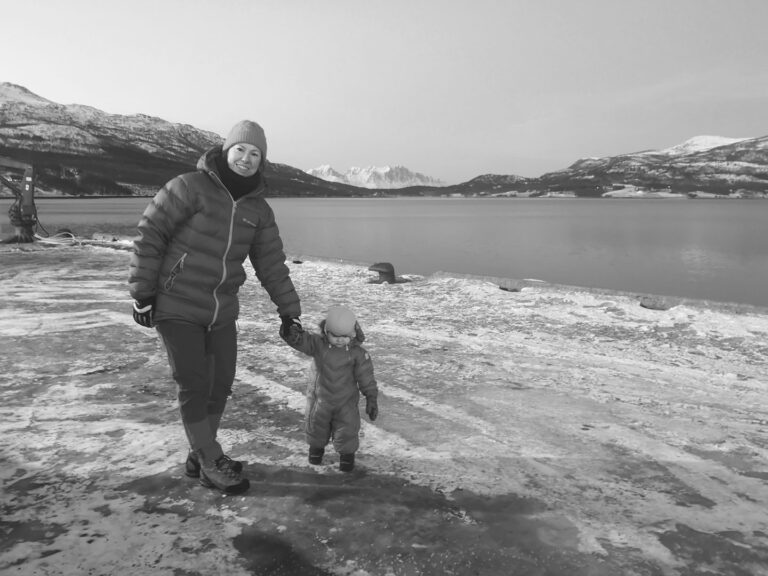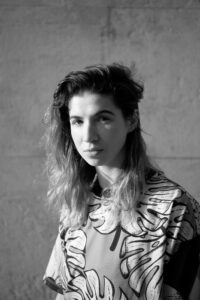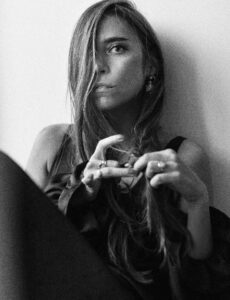Isabela Grosseová

– born in 1976. Isabela combines various approaches and methods in her practice, working as an artist, architect, sociologist and ethnographer. First of her works revolved around disciplines of art, design and architecture. Over time, she shifted her focus to the problematics of social dimensions of urban planning and architecture. For the last couple of years Grosseova has been exploring the theme of three interlacing figures-surfaces, mediating a peculiar triangle: artist – viewer – exhibition. In projects for which she invites viewers to participate, the boundary between the creator and the viewer becomes suspended and indefinite. She is one of the first Czech artists who, through her engaged practice, creates evaluative projects within institutional or post-colonial discourse. Currently, along with Dominik Lang she runs sculpture studio at UMPRUM in Prague.
“The fact that somebody is given the opportunity to make an exhibition is more important than what is shown at that exhibition” – Goran Trbuljak
„I applied for the painting studio, which I thought it’s quite ambitious.
It’s without any compromise. (…)
It really felt like I’m working on my future, and dream job, dream career,
which begin problematic afterwards”1.
She became interested in art as a child. Her mother, a sculptor herself, supported her in the first artistic attempts. Despite fondness for the world of numbers and mathematical equations, she decided to attend art high school. Later on, she started her university studies at the painting studio of AVU (Fine Arts Academy in Prague).
When asked about her visions for artistic work, career and life after the Academy, she admitted that at the beginning of her studies, these visions were naive, drew from the older generation of artists, the generation of her mother and her friends, who had been spending their time creating works in their ateliers, to sell it via Podnik Dílo. Everything seemed much easier and they looked happy, being able to do what they love and make a living. However, when Grosseova graduated the Academy, she realized the reality has little to do with what she remembered watching artists as a teenager.
“Artistic thinking which can be introduced in different professions, which happened to me in my architecture path.”2
After her graduation, Isabela worked as an architect and member of Josef Pleskot studio in Prague. What seemed to be a dream job at first became hardly stimulating after five years. During that time she met her partner and co-creator of future projects, Jaspear Alvear, who convinced her to quit her studio job and start working for herself. Grosseova began internship with New York architect and artist, Vito Acconci. Despite it being a six-month internship paid with lunches, it inspired Isabela to return to art, because “architecture cannot grasp all the topics, working pragmatically it cannot face the most complicated issues”3.
“My credibility at the moment is based on the failure of other artists. And this is a very problematic moment”4
After several years of building a career in architecture, Grosseova came back to solo artistic practice. The theme of artists of the dark matter of art became the focal point of her considerations. She focused her attention on the “invisible” graduates of artistic studies. Her PhD dissertation, „Gravity of Artistic Competence”, subtitled “The Unplanned Connection of Art and Life”, treats on commercialized art education in a Neo-liberal economic politics, where graduates of art studies finish their education to function parallel to the art world, making a living through precarious work. Thus, the demand, supply and competitive equation is an experience without an alternative – a dictate defining success – circulation in the art world or failure, coupled with unprofitability and coercion to adopt half-measures. During her four-year research, Grosseova conducted several dozen interviews with the Academy graduates who were pushed into various, often surprising professions to provide for themselves. There was a painter, who ran a therapeutic practice, an artist who became a priest (however, he saw it as one of his art projects), or a conceptual artist, who trades in real estate. “It is very hard to admit to abandoning art, people blame themselves for it.” The artist examines how the creative potential can be utilized outside of the realm of art, in lines of work that can hardly be described as creative.
In 2005 Grosseova started cooperation with Jasper Alvaer. Among other projects, they created “Transculture”, a three-act project devoted to problematics of social awareness and European identity facing progressing globalization5. The duo drove along the borders of the European Union – from North Africa all the way to the north of Norway. They gave voice to provincial capitalism, looked at peripheries of the euro-centric map. The trip became a project registering accidental materiality of everyday, unregulated trade – local products sold by roadside vendors. Random meetings were registered through photography and by artifacts: the collection of purchased items, which attempt to capture the culture of “things” as a medium itself, communicating much more than circulation of goods on its own. The artists created a material-symbolic interpretation of everyday life scenography in the context of micro-history and anthropology of daily life, which allowed to reveal further purposes and meanings.
The first installment of the “Transculture” project (2006)6 was the exhibition at the Atrium of Moravska Gallery in Brno, where the artists showed artifacts from Czech collection, both public and private, coming from the countries, which they visited during their trip. The objects on display were supplemented with descriptions of the context of the journey of these objects to the Czech collection, as well as items from their private archive – what they gathered throughout their trip. However, the real focal point of the project were people – meetings they experienced along the way. Five of them attended the exhibition in Brno and shared their experiences with the viewers in a form of public debates, presentations and film screenings.
One year later, the project was continued in Krakow’s Bunker of Art, by the name “Figure and Ground” (2007)7. The exhibition, curated by Anna Smolak and Magdalena Ujma, presented the journey along North Africa and Eastern Europe, documented with a series of photographs depicting roadside vendors and their goods in a local cultural / landscape context. Thus, it was focused on what is marginal, what takes part in perception parallel and fully subordinate. The products the artists brought from their journey were also presented along with recordings of specialists, talking about historical and cultural contexts of plants, fruit and vegetables, reflecting the history of migrations, discoveries, trade routes and global trade agreements. At the time, Poland had been a member of the EU for only three years. Grosseova and Alvear analyzed how it affected the landscape of the European outskirts, peripheries of peripheries, focusing their attention towards margins of reality outside the media narration of the mainstream. The Polish edition was enriched by comments from Piotr Bikont, Robert Makłowicz, Łukasz Łuczaj and others.
* * * * *
“Is it possible to view the resignation from an artistic career as positive in some cases? Is it possible to imbue the non-artistic world with artistic competence?”8
During Grosseova’s research for her PhD dissertation, she created three research exhibitions: “Competence” (2015) in Fotograf Gallery in Prague (cooperation with Jasper Alvear and Jiří Ptáčkek, “Vůbec mne nezajímaly výstavy” [I didn’t care about the exhibitions] in AVU Gallery (2017) and “Průraz” [Certificate] in Entrance Gallery (2017). In the first one, Grosseova researched the concept of artistic competence. The exhibition’s goal was to spark a creative potential among recipients, their engagement to be the key element of the exhibition. Each visitor was to face the classic task for young adepts of art: create a drawing of their own hand9. All of the drawings remained in the gallery, becoming part of the exhibition. The viewers’ experience was enriched with recordings of conversations with art graduates, who did not continue their career in art, for example mister J., who started a prosperous computer company after graduating art (however, as he states, he knows little about computers.)
In her work Grosseova blurs the boundaries between the creator and the recipient, giving priority to the latter. In a way she became a catalyst, which along with the audience dissolves her role of professional artist. The viewers experience the creative process and the experiences themselves become works of art.
“I don’t work with external topics. The central point of my practice is my life.”10
Written in cooperation with Jolanta Nowaczyk (2021).
1Jolanta Nowaczyk, Interview with Isabela Grosseova, online, 17.10.20202Jolanta Nowaczyk, Interview with Isabela Grosseova, online, 17.10.2020
3Interview with Isabela Grosseova, Artycok.TV, 1.10.2018, see: artycok.tv/41429/41429.
4Grosseova I., Gravity of Artistic Competence, 2020, str. 12
5Image: Isabela Grosseová, Transkultura, 2006. Courtesy of the artist.
6Image: Isabela Grosseová, Transkultura, Akt 1, 2006. Courtesy of the artist.
7Image: Isabela Grosseová, Figure and Ground, Bunkier Sztuki. Courtesy of the artist.
8Grosseova I., „Gravity of Artistic Competence”, 2020, str. 5
9Image: Isabela Grosseová, Exhibition. Eligibility. Courtesy of the artist. Spectatrix shows her hand and drawing of her hand to the gallery backstage.
10Grosseova I., Gravity of Artistic Competence, 2020, str. 128
– narozena 1976 ve své tvůrčí praxi propojuje různé přístupy a metody, využívá nabyté zkušenosti výtvarnice, architektky, socioložky a etnografky. Její první práce se pohybovaly na pomezí umění, designu a architektury. V posledních letech Grosseová využívá motiv pronikání tří postav-platforem v rámci mediace určitého trojúhelníku: umělec – divák – výstava. V projektech, v nichž vyzývá diváky k účasti, zůstává hranice mezi tvůrcem a divákem přerušená a zastřená. Je jednou z prvních umělkyň v Česku, která prostřednictvím své angažované tvorby vytváří kritické projekty v rámci institucionálního či postkoloniálního diskurzu. V současné době spolu s Dominikem Langem vede ateliér sochařství na pražské UMPRUM.
“The fact that somebody is given the opportunity to make an exhibition is more important than what is shown at that exhibition” –Goran Trbuljak
„I applied for the painting studio, which I thought it’s quite ambitious.
It’s without any compromise. (…)
It really felt like I’m working on my future, and dream job, dream career,
which begin problematic afterwards”1.
O umění se začala zajímat ještě v dětství. Její matka, povoláním sochařka, ji podporovala při prvních tvůrčích pokusech. Ačkoli ji to více táhlo do světa čísel a matematických operací, rozhodla se pro výtvarnou střední školu. Poté zahájila studium na Akademii výtvarných umění v Praze.
Na otázky ohledně vizí své tvorby, kariéry a života po akademii přiznává, že ještě začátkem studia měla značně naivní představy: měla totiž v živé paměti vzpomínky na starší generaci umělců, generaci své matky a jejích přátel, kteří trávili čas ve svých ateliérech, kde tvořili, a poté své práce prodali prostřednictvím podniku Dílo. Všechno se zdálo mnohem jednodušší a oni vypadali šťastně – mohli dělat to, co mají rádi, a ještě si tím vydělávat. Ale když ona sama absolvovala akademii, ukázalo se, že realita se velmi ostře liší od toho, co se jí vrylo do paměti, když pozorovala život umělců jako náctiletá.
„Artistic thinking which can be introduced in different professions, which happened to me in my architecture path.”2
Po ukončení AVU Isabela pracovala jako architektka v týmu studia Josefa Pleskota v Praze. Zpočátku to pro ni byla práce snů, ale po pěti letech ji už tolik nestimulovala. V té době se seznámila se svým partnerem, dlouholetým spolutvůrcem svých pozdějších projektů, umělcem Jesperem Alvaerem, který ji podnítil k rozhodnutí zanechat práce v architektonickém studiu a hledat vlastní cestu. Isabela zahájila praxi u newyorského architekta a umělce Vita Acconciho. Byla to sice půlroční stáž za symbolickou odměnu, ale Grosseová se po ní vrátila k umění s novou inspirací, protože „v architektuře nejsou obsažená všechna témata, architekt vlastně pracuje docela pragmaticky a formálně, nezpracovávají se tam úplně komplikovaná zadání.“3
„Můj kredit umělce je v tuto chvíli založený na neúspěchu jiných umělců. A to je velmi problematický moment”4
Když se po několika letech strávených budováním kariéry v architektuře Grosseová vrátila k samostatné umělecké tvorbě, středobodem jejích úvah se stalo téma umělců mimo umělecké výsluní – svou pozornost zaměřila na „neviditelné“ absolventy uměleckých oborů. Její doktorská práce s názvem Gravitace umělecké kompetence s podtitulem Neplánované splynutí umění a života se zabývá perspektivou uměleckého vzdělávání v tržním prostředí neoliberální ekonomické politiky, v níž absolventi uměleckých oborů nejčastěji ukončují školu a poté působí zároveň ve světě umění a zároveň provozují běžné zaměstnání, které jim umožní obživu. Bilance nabídky, poptávky a konkurenceschopnosti je tedy zkušeností bez jakékoli alternativy, neboli diktátem, který ovlivňuje pojem úspěchu – tedy zapojení do uměleckého provozu, nebo porážky spojené s nerentabilitou a nutností využívat polovičatá řešení. V rámci svých výzkumů Grosseová v průběhu čtyř let uskutečnila několik desítek rozhovorů s lidmi, kteří se po dokončení akademie ocitli v různorodých, někdy až překvapivých profesích a oborech, z nichž jim plynuly příjmy. Jako například malíř, který se uplatnil částečně jako terapeut, nebo umělec, který se stal knězem, ačkoli to považuje za jeden ze svých uměleckých projektů, nebo konceptuální umělkyně, která působí v oblasti obchodu s nemovitostmi. „Je velmi těžké se přiznat k opuštění umění, lidé si to kladou za vinu.“ Umělkyně zkoumá, jak se tvůrčí potenciál může uplatnit mimo pole umění – v oborech, které bývají jen zřídka považovány za kreativní.
V roce 2005 začala spolupracovat s Jesperem Alvaerem, výsledkem jejich spolupráce byl mj. projekt Transkultura (ve třech aktech), věnovaný problematice společenského vědomí a evropské identity tváří v tvář postupující globalizaci5. Dvojice absolvovala cestu autem podél vnějších hranic Evropské unie – od severní Afriky po sever Norska. Umělci tak nechali promluvit provincie kapitalismu, nahlíželi na periferie europocentristické mapy. Cesta se stala projektem zaznamenávajícím materiálno každodenního, neformálního obchodu – lokální produkty prodávané ve stáncích u cesty. Náhodná setkání byla zaznamenána prostřednictvím fotografií a také samotnými artefakty: sbírkou získaných předmětů, které se jakoby intuitivně pokoušejí zachytit kulturu „věcí“ jako svébytné médium, mnohem sdělnější než sám koloběh zboží. Byla to materiálně-symbolická interpretace scénografie všedního života ve znamení mikrohistorie a antropologie každodennosti, která umožnila odhalit jejich další smysly a významy.
Projekt Transkultura (2006)6 se poprvé představil na výstavě v Atriu Moravské galerie v Brně, kde umělci prezentovali artefakty z českých sbírek, jak veřejných, tak soukromých, pocházející ze zemí, které navštívili během své cesty. Prezentované předměty byly doplněny popisem kontextu, jak se tyto objekty dostaly do českých sbírek. Vystavené artefakty byly doplněny o předměty ze soukromého archivu umělců – věci nasbírané během cesty. Skutečnou osou tohoto projektu však byla setkání s lidmi, s nimiž dvojice navázala kontakt během výpravy. Pět z nich bylo pozváno na dobu konání výstavy do Brna, aby se mohli podělit o své zkušenosti s diváky – formou veřejných debat, prezentací či filmových projekcí.
O rok později se projekt rozvinul v krakovské galerii Bunkier Sztuki pod názvem Figure and Ground (Figura a pozadí, 2007)7. Výstava, jejímiž kurátorkami byly Anna Smolak a Magdalena Ujma, prezentovala cestu podél severní Afriky a východní Evropy, zdokumentovanou cyklem fotografií prodavačů u cesty a jejich zboží v lokálním kulturním a krajinném kontextu. Pozornost tedy byla věnována něčemu, co je okrajové a vlastně je považováno i za podřadné. Představeny byly také zakoupené produkty, k nimž byly nahrány komentáře odborníků, hovořících o historických a kulturních kontextech rostlin, ovoce a zeleniny – v nich tak se odrážela historie migrace, objevů, obchodních cest nebo globálních hospodářských dohod. Polsko tehdy mělo za sebou pouhé tři roky v Evropské unii. Grosseová s Alvearem zjišťovali, jak se mění krajina na okrajích EU, neboli periferiích periferie, svou pozornost zaměřili na okrajové záležitosti, na realitu mimo naraci mediálního mainstreamu. Komentáře k polské sbírce poskytli mj. novinář, kulinářský kritik a překladatel Piotr Bikont, publicista, cestovatel a kulinářský kritik Robert Makłowicz a botanik Łukasz Łuczaj.
* * * * *
“Is it possible to view the resignation from an artistic career as positive in some cases?
Is it possible to imbue the non-artistic world with artistic competence?”8
V rámci výzkumu k doktorské práci vznikly tři výstavy: Způsobilost (2015) v pražské Fotograf Gallery ve spolupráci s Jesperem Alvaerem a Jiřím Ptáčkem, dále výstava Vůbec mne nezajímaly výstavy v Galerii AVU (2017) a Průraz (2017) v Galerii Entrance.
V první z nich Grosseová zkoumá pojem uměleckých kompetencí. Cílem výstavy byl pokus o vytvoření tvůrčího potenciálu u diváků, a samotná jejich participace se měla stát klíčovou částí výstavy. Každý z návštěvníků se měl pustit do klasické úlohy, kterou dostávají mladí adepti umění: nakreslit vlastní ruku9. Všechny skici pak zůstaly v galerii a staly se součástí vlastní výstavy. Zkušenosti diváků byly doplněny audionahrávkou z rozhovorů s absolventy uměleckých vysokých škol, kteří po absolutoriu nepokračovali ve své umělecké dráze, jako je například pan J., který po ukončení školy uměleckého směru založil dobře prosperující počítačovou firmu, ačkoli tvrdí, že se v počítačích příliš nevyzná.
Grosseová stírá hranice mezi tvůrcem a divákem-vnímatelem, a na první místo staví právě diváky. Stává se tak jakýmsi katalyzátorem, který za spolupůsobení diváků „rozpouští“ svou profesionální roli umělkyně. Diváci zakusí tvůrčí proces a tyto jejich zážitky se samy o sobě stávají uměleckými díly.
“Nemám tedy externí téma, se kterým bych pracovala, ale můj vlastní život je v centru mé práce.”10
Text vznikl ve spolupráci s Jolantu Nowaczyk (2021).
1Jolanta Nowaczyk, Rozhovor s Isabelou Grosseovou, online, 17. 10. 2020.2RJolanta Nowaczyk, Rozhovor s Isabelou Grosseovou, online, 17. 10. 2020.
3Rozhovor s Isabelou Grosseovou, Artycok.TV, 1. 10. 2018, vid: artycok.tv/41429/41429.
4Grosseová I., „Gravity of Artistic Competence / Gravitace umělecké kompetence”, 2020, str. 121
5Obrázek: Isabela Grosseová, Transkultura, 2006. S laskavým svolením umělkyně. S laskavým svolením umělkyně.
6Obrázek: Isabela Grosseová, Transkultura, Akt 1, 2006. S laskavým svolením umělkyně. S laskavým svolením umělkyně.
7Obrázek: Isabela Grosseová, Figure and Ground (Figura a pozadí), 2007. S laskavým svolením umělkyně.
8Grosseová I., „Gravity of Artistic Competence / Gravitace umělecké kompetence ”, 2020, str. 5
9Obrázek: Isabela Grosseová, Výstava Způsobilost. S laskavým svolením umělkyně. Divačka ukazuje svou ruku a kresbu ruky do zákulisí galerie.
10Grosseová I., „Gravity of Artistic Competence / Gravitace umělecké kompetence”, 2020, str. 128


